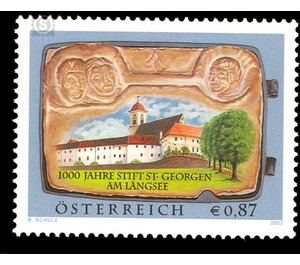1000 years - Austria / II. Republic of Austria 2003 - 87 Euro Cent
Theme: Architecture
| Country | Austria / II. Republic of Austria |
| Issue Date | 2003 |
| Face Value | 87.00 |
| Edition Issued | 500,000 |
| Printing Type | Photogravure |
| Stamp Type | Commemorative |
| Item Type | Stamp |
| Chronological Issue Number | 1755 |
| Chronological Chapter | OOS-OE2 |
| SID | 165974 |
| In 53 Wishlists | |
Between 1002 and 1008, Countess Wichpurch founded a Benedictine monastery, the first monastery in Carinthia, on her estates on the Längsee on the site of a small Georgskirche church. Probably the Countess has determined the coincidence of three circumstances for the foundation of a monastery for noble virgins: her husband, Count Ottwin of Sonnenburg, had pilgrimage to the Holy Land and lost there at that time. Her eldest daughter Hiltiburg was Chorfrau am Nonnberg, after all, her brother Hartwig had been Metropolitan of Salzburg since 991. The archbishop also consecrated the monastery and the new church of St. George and endowed it with all the spiritual and temporal powers that were customary at that time. Hiltiburg became the first abbess to succeed her sister Perchkunt after her death. The monastery was rebuilt after multiple destructions by the Hungarians, the Turks and by fires respectively. The four-sided courtyard, which is shared by the collegiate church, gives a renaissance arcade a particularly appealing character. 1654-58 were built by P. F. Carlone two-storey baroque wings with courtyard-side, also running along the south side of the church pillar arcades. 100 years later, another floor was added to these tracts. The former Gothic collegiate church with Romanesque stepped portal received a rich Baroque decor.


